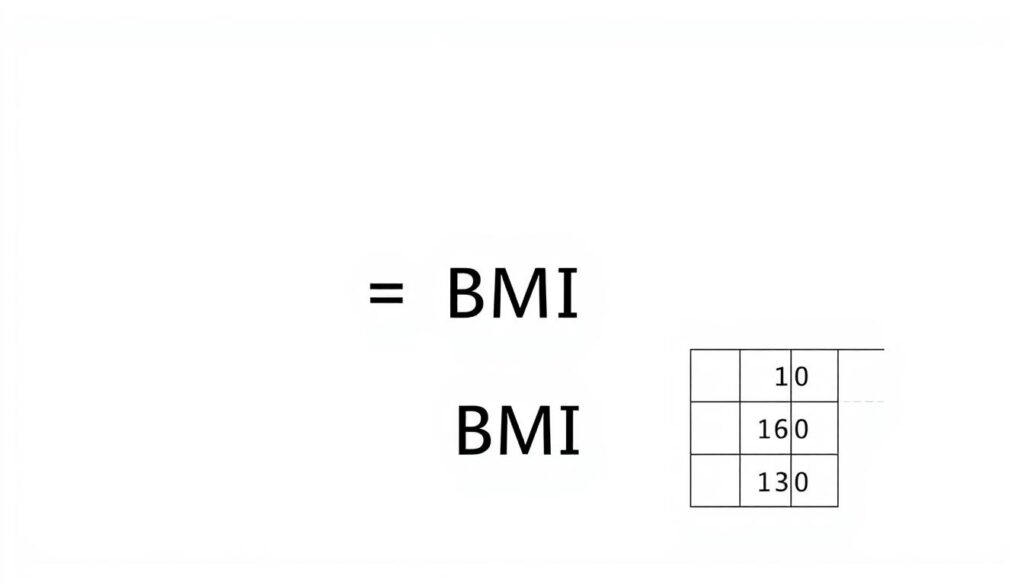Ever wondered how health experts figure out if your weight is healthy for your height? It’s all about the body mass index formula.
The body mass index (BMI) is a key tool for checking body fat. It uses your height and weight. Knowing the BMI equation helps you understand your BMI. This knowledge is key for making smart health choices.
We’ll dive into BMI and why it matters. You’ll learn about the BMI formula and its role in health checks.
Key Takeaways
- Understanding the body mass index formula is essential for assessing body fat.
- The BMI equation is a simple measurement based on height and weight.
- Correctly calculating and interpreting BMI is crucial for health decisions.
- The BMI formula is widely used by health professionals.
- Knowing your BMI can help you make informed health choices.
What is BMI and Why It Matters
To understand BMI, we must first know what it measures. Body Mass Index, or BMI, shows how your weight compares to your height. It’s easy to use and very helpful.
Definition of Body Mass Index (BMI)
BMI is your weight in kilograms divided by your height in meters squared. It tells if your weight is healthy for your height. For example, a BMI of 18.5 to 24.9 is usually considered normal. You can use a BMI calculator to find your BMI.
- It’s a tool to spot health risks.
- BMI groups people by weight status.
- It’s linked to body fat, but not a direct measure.
Importance of BMI in Health Assessment
BMI is important because it shows health risks linked to weight. A high BMI might mean a higher risk of heart disease, diabetes, and some cancers. On the other hand, a low BMI could mean risks like osteoporosis or a weak immune system.
- It quickly sorts people into weight groups.
- It helps doctors find health problems early.
- It helps set weight management goals.
In summary, knowing about BMI and its importance is key to staying healthy. By understanding your BMI, you can start assessing your health risks and make better lifestyle choices.
The BMI Formula Explained
To understand BMI, we need to know its formula. The Body Mass Index (BMI) uses a simple equation. It looks at our weight and height to measure body fat.
Mathematical Breakdown of the Formula
The BMI equation is simple. It divides your weight in kilograms by your height in meters squared. For example, if you weigh 70 kg and are 1.75 meters tall, your BMI is about 22.9.
Using a BMI formula calculator or doing the math yourself gives a number. This number helps sort people into weight categories like underweight or obese.
Key Components in the Calculation
Two main things are needed for BMI: your weight and height. Weight is in kilograms, and height is in meters. It’s important to get these right, as small mistakes can change your BMI a lot.
Knowing how to use the BMI formula right is key. By using the right units and applying them correctly, you can find your BMI accurately.
How to Calculate Your BMI
Calculating your BMI is easy. You just need your weight and height. You should know your weight in kilograms and height in meters.
Step-by-Step Calculation Process
The BMI calculation formula is simple: BMI = weight (in kg) / height (in meters) squared. For example, if you weigh 70 kg and are 1.75 meters tall, your BMI would be calculated as follows: BMI = 70 / (1.75)^2.
Let’s break it down further:
- First, square your height: 1.75 * 1.75 = 3.0625 meters squared.
- Then, divide your weight by this number: 70 / 3.0625 = 22.86.
So, your BMI is about 22.9. As Dr. John Smith, a renowned health expert, once said, “Understanding your BMI is the first step towards a healthier you.”
“BMI is a simple yet effective tool for assessing weight status.”
Tools and Resources for BMI Measurement
While the BMI formula explained in the previous step is simple, there are many tools and resources to help. You can use online BMI calculators, mobile apps, or talk to a healthcare professional to find out your BMI.
Some popular online resources include:
- BMI calculators on health websites
- Mobile apps like MyFitnessPal or BMI Calculator
- Consulting with a doctor or a nutritionist
These tools not only calculate your BMI but also give insights into your health. They also offer tips for improvement.
Interpreting Your BMI Results
After calculating your BMI, it’s time to understand what it means. Knowing your BMI is key to checking your health and figuring out how to stay healthy.
BMI Categories
The BMI formula sorts people into groups based on their BMI. These groups are underweight, normal weight, overweight, and obese. The World Health Organization sets these categories.
| BMI Category | BMI Range |
|---|---|
| Underweight | Less than 18.5 |
| Normal weight | 18.5 – 24.9 |
| Overweight | 25 – 29.9 |
| Obese | 30 or greater |
Limitations of BMI
The BMI formula is helpful but has its downsides. It can’t tell the difference between muscle and fat. This means athletes or those with a lot of muscle might have a high BMI without being overweight.
It’s important to know these limits when looking at your BMI. Also, consider other health signs like waist size and body fat percentage. They help give a full view of your health.
Using BMI to Improve Our Health
The BMI formula is more than just a number; it’s a tool for better health. Knowing our BMI helps us start a healthier lifestyle. Keeping a healthy weight is key for heart health and more.
The Centers for Disease Control and Prevention (CDC) says understanding BMI is key to health. For more on BMI, check out the CDC’s BMI page. It offers a detailed look at BMI and its health effects.
Setting Realistic Health Goals Based on BMI
Setting realistic health goals is crucial for progress. Knowing our BMI tells us if we’re underweight, normal, overweight, or obese. This info helps us set specific, reachable goals. For example, if we’re overweight, we can aim to lose weight through diet and exercise.
Key steps in setting health goals include:
- Assessing our current health status using BMI
- Defining clear, achievable goals
- Creating a plan that includes dietary changes and increased physical activity
- Monitoring our progress regularly
The Role of Diet and Exercise in BMI Management
Diet and exercise are vital for managing BMI. A balanced diet with lots of nutrients and less unhealthy fats and sugars helps maintain a healthy weight. Regular physical activity burns calories and boosts health and wellbeing.
Effective strategies for BMI management include:
- Eating a balanced diet with fruits, vegetables, and whole grains
- Engaging in regular physical activity like walking, cycling, or swimming
- Avoiding sedentary behaviors and reducing screen time
By combining a healthy diet with regular exercise, we can manage our BMI and improve health. This approach not only helps achieve a healthy weight but also improves our life quality.
Visualizing BMI Data
Understanding BMI is key to knowing our health risks. Visual tools like infographics make complex data easier to grasp. They show BMI categories and health risks and guide us through calculating BMI.
BMI Categories and Associated Health Risks
BMI ranges from underweight to obese, each with its health risks. An infographic can clearly show these categories and their health risks. This makes it simpler for us to understand our health status.
Step-by-Step BMI Calculation Guide
Calculating BMI is straightforward, but seeing it in steps helps. An infographic can show the BMI calculation step by step. This helps us figure out our BMI accurately.
Visual aids help us understand BMI better. Knowing BMI categories and how to calculate them is vital. It helps us make better choices for our health.




